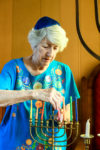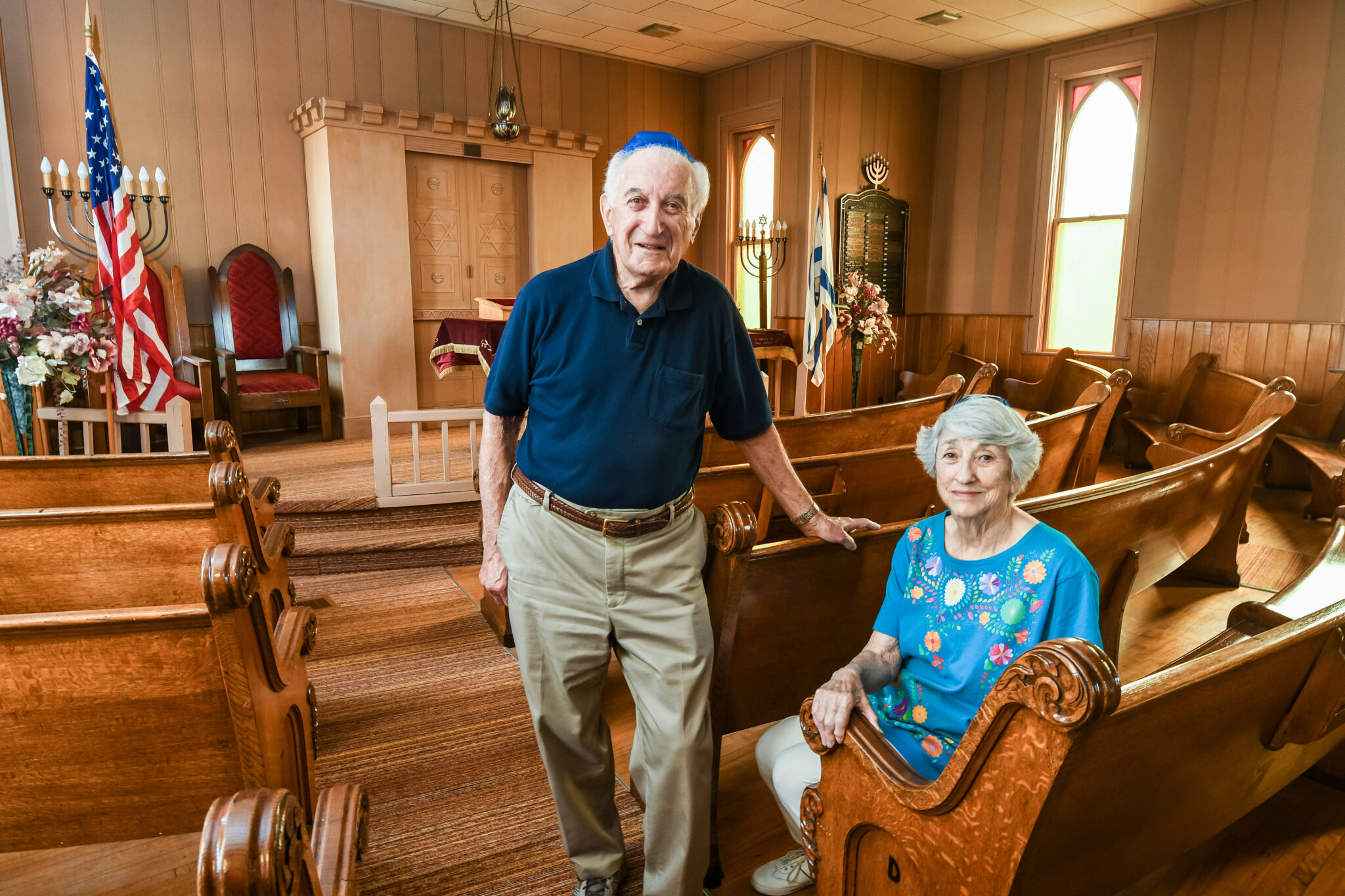

I first met with Herschel and Bea Premack for this story a week after the Jewish holiday of Passover. Typically, all families in the congregation are invited to a full Seder, a meal preceded by the telling of God’s deliverance of the Jews from slavery in ancient Egypt. Due to the pandemic, however, they planned what Herschel called a mini-Seder. He was pleased to say about 15 people came, noting it was about double the normal attendance for regular weekly services. It’s a sign of hanging on for a community whose impact in Aberdeen outweighs its declining numbers.
A Place of Their Own
Aberdeen has had a Jewish community since before 1887. That was when the Strauss family, the first recorded Jewish family in the city, arrived—and found another Jewish family already here. The several families in the area identified themselves as an informal congregation as early as 1908.
In the beginning, the congregation held services in rented space on the second floor of the Northwestern Public Service building on the southwest corner of Fourth Avenue and South Main Street, welcoming families from surrounding towns who came to worship. According to reports, the first formal religious services were conducted during the Jewish High Holidays of Rosh Hashanah and Yom Kippur in fall 1915. The next year, the congregation of at least 60 worshipers began planning to build a synagogue, but those plans changed.
In March 1917, the group formally chartered as Congregation B’nai Isaac. The name Premack was among the charter members of a growing congregation, and Herschel reported that his father came to Aberdeen around this time to join the other families. A few months later, in August, the newly named congregation bought the Wesleyan Methodist church on Second Avenue and North Kline. This space became their synagogue, and they celebrated the 1917 High Holidays in their own building that fall.
As one of the oldest buildings in Aberdeen, B’nai Isaac is the oldest of only three active synagogues in state. Over the years, the building has gradually changed. A 1951 remodeling replaced the steeple with a peaked roof, added a full basement, removed the front steps, and enlarged the entrance.
Perseverance of Faith

The synagogue has several Yahrzeit memorial boards that contain the names of deceased family and congregation members. This one dates back to the early years of the congregation while newer ones feature names in bronze.
About a dozen rabbis served the congregation over 60 years, starting with Julius Hess, who arrived in 1914 and guided its charter and the move into the synagogue. Through those years, the congregation’s size rose and fell, reaching about 60 families shortly before World War II.
In its first few decades, the congregation followed the Orthodox movement in Judaism, the most strictly observant of tradition of the three broad branches of the faith—Conservative and Reform being the other two. One example of a practice in the Orthodox congregation is that men and women sit separately in worship. Bea said, “In the early days here, only men were required to come to synagogue—women weren’t counted” as part of the minyan (quorum) of 10 men required for a service “because they had more important things to do, such as caring for the family and the home.”
Over time, larger changes eventually came to the congregation. “After World War II, young men came home from the war with newer ideas, and they took over,” Herschel said. Around the same time, some of the older Orthodox members left Aberdeen to live closer to children who had moved away.
In 1949, a B’nai Isaac congregation of 29 people (fewer than before the war) adopted affiliation with the Conservative movement—a view of the faith that understands Jewish law as binding but also evolving and not fixed. Women became more involved and joined the men in fulfilling the minyan. Bat Mitzvah for girls was another addition of this movement. In the early 1950s, B’nai Isaac joined United Synagogue of Conservative Judaism.
In the seven decades since, numbers have declined in the congregation, yet B’nai Isaac has persevered. Its local organizational chapters continued to stay active into the 1990s by raising money for local and international causes through events like rummage sales at the synagogue or selling baked goods at Arts in the Park. While there were fewer children, United Synagogue Youth held a regional conference in Aberdeen in 1972 that drew people from several states and Canada. Nationally known poet Danny Siegel attended and wrote a poem about the local congregation that hangs in the synagogue.
B’nai Isaac congregation has also had to make do without a rabbi since the 1970s, but Herschel has served as lay worship leader. Sometimes, the congregation brings in a rabbi or cantor to perform holiday services. In 2004, Rosh Hashanah coincided with Central High School’s all-school reunion, and many Jewish alumni visited the synagogue and attended services.
The congregation’s perseverance might be best recognized in the 2017 celebration of the synagogue’s 100-year anniversary and the building’s listing on the State Register of Historic Places in March 2021.
Setting Up Shop
Outside the synagogue, Jews have been active in the Aberdeen community in many ways. They were involved in business, politics, education, sports, and charity. Some early Jewish settlers were drawn to the Aberdeen area by the Jewish Agricultural Aid Society’s effort to encourage Jews to farm. Some worked as doctors or attorneys, and others ran various kinds of businesses. Herschel’s family ran a scrap dealing business for decades. Most arrivals, however, tended to work in retail trades, and Jewish grocers served many neighborhoods in town.
Several Jewish-owned businesses thrived. Some long-lasting, well-loved businesses were marked by their confidence in their new hometown. The impact of all these businesses is significant to the growth of the Aberdeen community. A brief look into three former Main Street staples shows this.
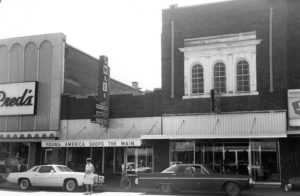
A photo from the Brown County Assessor’s Office shows both Pred’s building and Frank’s The Main on the 200 block of Main Street.
Pred’s. Born in France and raised in Russia before traveling to Nebraska, Isaac Predmestky—later abbreviated to “Pred”—was a peddler who stopped in Aberdeen around the early 1910s. With an entrepreneurial enthusiasm that would prove to be infectious among other Jewish businessmen, he found “a bustling, thriving town, like a little metropolis with streetcars and restaurants serving menus every bit as good as those found in New York City.” In 1916, he opened a shop here and sent his twenty-something sons Abe and Dan to run it.
Aberdeen became Abe’s town. He operated multiple women’s fashion stores over the years, including The Paris and The Hollywood Shop, which was renamed Pred’s in 1945. The store locations moved around but settled at 220 S. Main St. in 1964. Much like his father, Abe said he bought the building, “as an expression of confidence in the future growth of Aberdeen and the Main Street business community.” Around the same time, Abe’s son, Jack, bought into the business and eventually became its owner. He would see the same promise his grandfather and father had, saying, “I really believe that Aberdeen, the business community, is probably better than any other community I’ve seen of a town of this size. And it’s certainly better than a lot of towns I’ve seen that are larger than Aberdeen.”
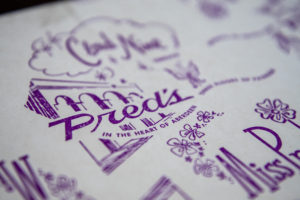
The Dacotah Prairie Museum has a few retail artifacts from various stores downtown in Aberdeen. Above is a garment box featuring three separate Pred stores—Pred’s, Cloud Nine, and Miss Pred’s.
By the 1990s, Pred’s downsized to focus on coats. Perhaps an optimist in a period when stores were leaving Main Street (some to the new mall on the east side of town), Jack believed business prospects were good “primarily due to the fact we have a mall that is going to help extend our trade area and bring people into the community.” In 1992, after more than 75 years on Main Street, Pred’s Coats moved to the mall. In what would become a recurring theme, Jack’s sons chose to pursue other career paths, and in 1995, Jack sold the store.
Feinstein’s. In 1924, brothers Abe and Sol Feinstein bought a shop in the Ward Hotel (some later reports said it was the Sherman Hotel). Six years later, they moved their Golden Rule Store to 317 S. Main St., stating, “We have splendid confidence in the future of Aberdeen and the surrounding territory.” Reporting on the store’s grand opening, a newspaper lauded its “popular modernistic design” and its “gorgeous font, which would do credit to a Fifth Avenue store in New York city.” A 1952 fire in the store forced a move to 307 S. Main St. In between these events, Feinstein’s Bootery also opened downtown.

Like Pred’s, the Feinstein family operated different storefronts downtown in Aberdeen on the 300 block of Main Street. Their facades were uniquely modern for the time and were surely the place to shop in town.
In 1953, Sol’s son Manley came to manage what had become Feinstein’s Ready to Wear and expanded it, adding a bridal and formal shop as well as a youth shop. In the 1980s, Manley’s son, Marc, became the third generation to manage the store. Feinstein’s had opened branch stores around the area but sold them to concentrate on the Aberdeen shop, which continued to expand. The store always focused on women’s fashions and was known for the children’s slide on the stairs that led to the basement. While it thrived for years, Feinstein’s closed in 1993 after Marc went to law school at USD.
The Main. Burton Frank came to Aberdeen in 1947 from St. Paul following his service in World War II. In 1951, after a few years working for Goodman News and Arcola Grocery, he opened a war surplus store in what is now the Dacotah Prairie Museum. Four years later, Burton moved his store to 218 S Main St.
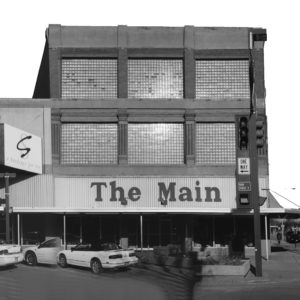
The Frank family operated a couple stores downtown as well. Both Mister’s Mens Wear and The Main were downtown staples and maybe the best place to get men’s suits and clothing. The Main was last in the Olwin-Angell building on the corner of Fourth and Main. Mister’s is now The Workshop, containing many small business offices and the Aberdeen Downtown Association (208 S. Main St.).
Over time, his store changed to The Main and focused on men’s clothes. Years later, the Franks eschewed a move to rumored malls coming to town because, as Burton’s son, Steve, said, “Downtown Aberdeen is here to stay. It’s one of the strongest downtowns in the entire Midwest.”
In 1983, a dream came true for the Franks when they bought the former Olwin-Angell Department store at 321 S. Main St. Burton called it “the best corner in town.” Perhaps providentially, it was across the same intersection where Jews first worshiped in Aberdeen, thirty years before Burton arrived. “I’ve been in love with that building a long time—maybe 25 years. … That’s the best retail corner in both North Dakota and South Dakota,” Burton said. More broadly, he asserted, “Downtown Aberdeen retail-wise is the best in northeast South Dakota. We have good stores, and everybody is spending a lot of money to fix up.” By the 1990s, the Franks also owned Mister’s Men’s Wear and the Uptown Mini-Mall. In a familiar theme, however, Steve’s son was not interested in taking over the business. In 2003, The Main closed, marking the end of the three perhaps most prominent Jewish-owned stores in Aberdeen.
Very Strong Acceptance
The number of Jews compared to the rest of the Aberdeen population has always been small, but they have never truly felt like outsiders in this community.
Herschel and Bea insist that being Jewish has not affected their ability to live and do as they please in Aberdeen. “Whenever our children have been involved in activities, there’s been a very strong acceptance,” Bea said. “We have always seen that. We’ve also been very straightforward with our identity, and that’s made Aberdeen a very good place to live.”
Over the past century, many Jews told of loving Aberdeen.
Rabbi Abraham Kertes, who arrived in 1953, noted, “Aberdeen is my real home, not just a residence. The people of Aberdeen are my friends. From the mayor to all my neighbors, I love them all as my brothers who deserve to be loved, without regard to what church they attend.” Similarly, the son of Rabbi Aaron Hardin, who came in 1923, recalled to Bea, “My parents loved Aberdeen and the people there. I think it was the happiest time of their lives.”
“There’s been no problem with acceptance of Jewish people,” Bea reiterated. The congregation’s proactive approach might have contributed to this. For decades, they have invited people to the synagogue to learn about Judaism. A Christian group was scheduled for the weekend after we spoke.
Given this sense of acceptance, it’s not surprising that Bea has been a part of making recent newcomers feel welcome in Aberdeen. She has been a part of the Aberdeen Area Diversity Coalition since its earliest days and said, “There’s huge diversity in the community, and we need to make a real effort to welcome people.”
It may seem patronizing to point out the accomplishments of local Jews, like the Premacks and the business owners, as though it’s surprising. When looking at the numbers, Jewish families are only a small fraction of the total population in Aberdeen. That count is consistent with the surprisingly small worldwide population of Jews, which is estimated to be 15 to 24 million. In that sense, the impact of local Jews is a case of overachieving. Jewish families have always been a part of Aberdeen, and even though their numbers have declined, they continue to leave their mark on the community. //
Writer’s note: It’s a fool’s errand to try to write a history of a culture of a relatively small group of people in a relatively small place like Aberdeen, but the publisher found his man. I’m grateful for learning from visits with Herschel and Bea Premack; Bea’s paper on the history of Aberdeen’s B’nai Isaac congregation; “Fewer Rabbis than U.S. Senators: Jewish Political Activism in South Dakota,” by Art Marmorstein et al. in The Plains Political Tradition (volume 3); and the K.O. Lee Aberdeen Public Library. Thanks also to Steve Frank, former owner of The Main men’s clothing store on Main Street.
Is it Kosher?
In slang usage, “kosher” has come to mean acceptable or “by the rules,” but its original meaning comes from traditional Jewish dietary laws. It is one of the most recognized—if little understood—Jewish religious practices. “Kosher means ritually clean food,” Herschel explained. “For example, meat needs to be ritually slaughtered, meaning the least painful way to slaughter an animal.”
Keeping kosher includes the practice of choosing dairy or meat for meals. “If you have a meat meal, there is no dairy; if you have a dairy meal, there is no meat,” Herschel said. Meals can also have neutral foods, like fruit and vegetables. Some foods in stores have a rabbinical stamp if they are kosher.
From the early days in Aberdeen until today, Jews who keep kosher (not all do) have had to order most of their meat from out of town.
At the front of the worship space in B’nai Isaac is the Aron Kodesh—an ark that holds three scrolls, each a complete Torah. Central to Jewish worship is the Torah, the five books of Moses, which correspond to the first five books of the Christian Old Testament.
“It’s considered an honor and a privilege to be called up to participate in the reading of the Torah,” Bea explained. Young people read from the Torah during their Bar Mitzvah (for boys at 13) or Bat Mitzvah (for girls at 12) as a part of becoming adults in the faith. The Torah is read three days each week, including the Sabbath, which begins at sunset on Friday and ends at sunset on Saturday. Holidays also begin at sunset, and each includes a worship service, although some tend to be observed at home. “For every holiday, there’s special food,” Bea added.

The B’nai Isaac Congregation Synagogue is located on the corner of Second Avenue Northeast and North Kline Street, right beside St. Mary’s Church. In 1917, the congregation acquired the building from the Wesleyan Methodist church.
Local Chapters
In the first few decades after officially becoming Congregation B’nai Isaac, the families of the synagogue established local chapters of national and international groups. In 1924, women organized a chapter of Hadassah, which helped support Jewish communities worldwide. In particular, the local chapter assisted the international organization with the construction of the first hospital in what would become Israel. The hospital is still open to all people today. A few years later, Jewish Ladies Aid convened to look after the congregation’s needs. In 1926, a chapter of B’nai Brith, an international men’s service organization, was launched. These organizations were recognized for contributions to the congregation and the Aberdeen community. In 1945, the Dakotas Council of B’nai Brith held a regional meeting in Aberdeen that drew Governor M.Q. Sharpe and Mayor O.M. Tiffany. In 1975, Governor Richard Kneip recognized Hadassah at a meeting in Aberdeen.
Renaissance Man

But outside the store, Abe may have been most recognized for athletics and his accomplishments in boxing, wrestling, and baseball. Abe was probably best known for sponsoring Pred’s amateur baseball team, which won six state championships and was national runner-up twice. In 1962, he was named to the state’s amateur baseball hall of fame. Longtime Smittys coach and Pred’s outfielder Reedy Fossum summed up in his history of the Pred’s team, “Too bad there aren’t more Abe Preds around.”
Bea Premack has served on boards at Northern State University and Presentation College and helped establish the Aberdeen Area Arts Council. She earned the Chamber’s Woman of Spirit Award, the Exchange Club’s “Golden Deeds” award, and was named to the South Dakota Advisory Committee to the U.S. Civil Rights Commission. Bea was also named First Lady of Aberdeen for her many contributions to the community.













